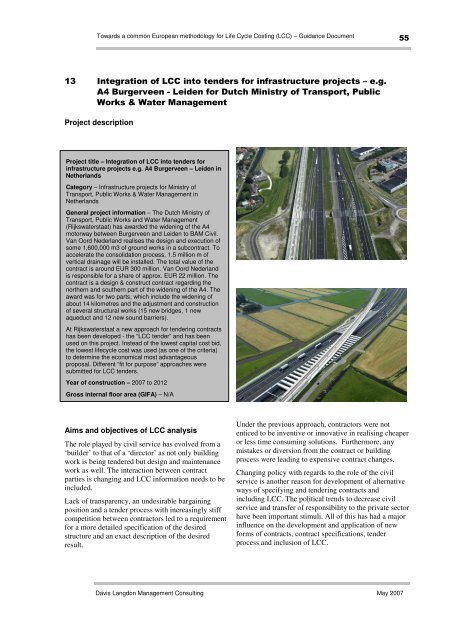Life cycle costing (LCC) as a contribution to sustainable construction ...
Life cycle costing (LCC) as a contribution to sustainable construction ...
Life cycle costing (LCC) as a contribution to sustainable construction ...
You also want an ePaper? Increase the reach of your titles
YUMPU automatically turns print PDFs into web optimized ePapers that Google loves.
Towards a common European methodology for <strong>Life</strong> Cycle Costing (<strong>LCC</strong>) – Guidance Document<br />
55<br />
13 Integration of <strong>LCC</strong> in<strong>to</strong> tenders for infr<strong>as</strong>tructure projects – e.g.<br />
A4 Burgerveen - Leiden for Dutch Ministry of Transport, Public<br />
Works & Water Management<br />
Project description<br />
Project title – Integration of <strong>LCC</strong> in<strong>to</strong> tenders for<br />
infr<strong>as</strong>tructure projects e.g. A4 Burgerveen – Leiden in<br />
Netherlands<br />
Category – Infr<strong>as</strong>tructure projects for Ministry of<br />
Transport, Public Works & Water Management in<br />
Netherlands<br />
General project information – The Dutch Ministry of<br />
Transport, Public Works and Water Management<br />
(Rijkswaterstaat) h<strong>as</strong> awarded the widening of the A4<br />
mo<strong>to</strong>rway between Burgerveen and Leiden <strong>to</strong> BAM Civil.<br />
Van Oord Nederland realises the design and execution of<br />
some 1,600,000 m3 of ground works in a subcontract. To<br />
accelerate the consolidation process, 1.5 million m of<br />
vertical drainage will be installed. The <strong>to</strong>tal value of the<br />
contract is around EUR 300 million. Van Oord Nederland<br />
is responsible for a share of approx. EUR 22 million. The<br />
contract is a design & construct contract regarding the<br />
northern and southern part of the widening of the A4. The<br />
award w<strong>as</strong> for two parts, which include the widening of<br />
about 14 kilometres and the adjustment and <strong>construction</strong><br />
of several structural works (15 new bridges, 1 new<br />
aqueduct and 12 new sound barriers).<br />
At Rijkswaterstaat a new approach for tendering contracts<br />
h<strong>as</strong> been developed - the “<strong>LCC</strong> tender” and h<strong>as</strong> been<br />
used on this project. Instead of the lowest capital cost bid,<br />
the lowest life<strong>cycle</strong> cost w<strong>as</strong> used (<strong>as</strong> one of the criteria)<br />
<strong>to</strong> determine the economical most advantageous<br />
proposal. Different “fit for purpose” approaches were<br />
submitted for <strong>LCC</strong> tenders.<br />
Year of <strong>construction</strong> – 2007 <strong>to</strong> 2012<br />
Gross internal floor area (GIFA) – N/A<br />
Aims and objectives of <strong>LCC</strong> analysis<br />
The role played by civil service h<strong>as</strong> evolved from a<br />
‘builder’ <strong>to</strong> that of a ‘direc<strong>to</strong>r’ <strong>as</strong> not only building<br />
work is being tendered but design and maintenance<br />
work <strong>as</strong> well. The interaction between contract<br />
parties is changing and <strong>LCC</strong> information needs <strong>to</strong> be<br />
included.<br />
Lack of transparency, an undesirable bargaining<br />
position and a tender process with incre<strong>as</strong>ingly stiff<br />
competition between contrac<strong>to</strong>rs led <strong>to</strong> a requirement<br />
for a more detailed specification of the desired<br />
structure and an exact description of the desired<br />
result.<br />
Under the previous approach, contrac<strong>to</strong>rs were not<br />
enticed <strong>to</strong> be inventive or innovative in realising cheaper<br />
or less time consuming solutions. Furthermore, any<br />
mistakes or diversion from the contract or building<br />
process were leading <strong>to</strong> expensive contract changes.<br />
Changing policy with regards <strong>to</strong> the role of the civil<br />
service is another re<strong>as</strong>on for development of alternative<br />
ways of specifying and tendering contracts and<br />
including <strong>LCC</strong>. The political trends <strong>to</strong> decre<strong>as</strong>e civil<br />
service and transfer of responsibility <strong>to</strong> the private sec<strong>to</strong>r<br />
have been important stimuli. All of this h<strong>as</strong> had a major<br />
influence on the development and application of new<br />
forms of contracts, contract specifications, tender<br />
process and inclusion of <strong>LCC</strong>.<br />
Davis Langdon Management Consulting May 2007







